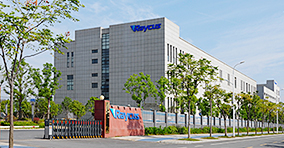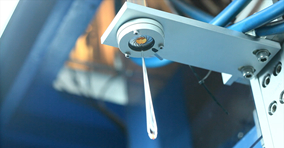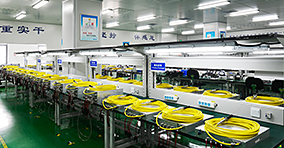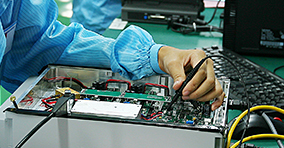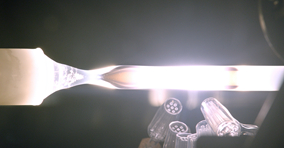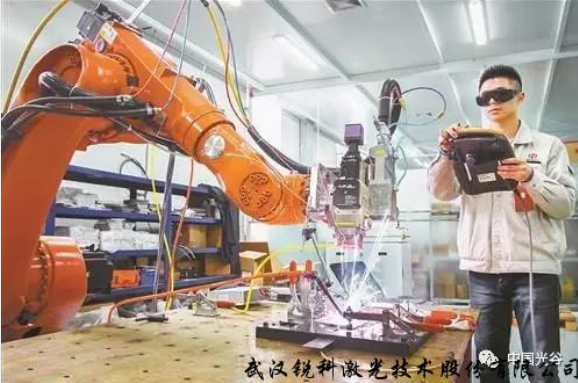On April 14th, in its “Innovative Enterprise China Tour” series of reports, Chongqing Daily focused on the entire China Optics Valley . From the innovation achievements of Optics Valley companies and the strong support of Optics Valley policies, it described the innovations taking place in Optics Valley. story.

”
Wuhan East Lake New Technology Development Zone, known as “Optical Valley”.
Here, China’s first optical fiber and the first 10,000-watt fiber laser were born, which are at the international advanced level in the field of optical communications.
Today, the optical fiber and cable industry in Optics Valley has an international market share of 25%, the laser and other optical device industries have an international market share of 12%, and the domestic market share of both industries exceeds 60%.
Here, in an area of 518 square kilometers, there are more than 300,000 professional and technical personnel and more than 800,000 college students.
Here, in 2016, an average of 59 new companies, 44 patents, and 15 master’s degrees or more were added every working day. During the “Twelfth Five-Year Plan” period, the total revenue of enterprises maintained a growth rate of more than 25%.
Each item of data outlines a robust and innovative “ECG”.
Betta Fish Legend
Douyu staff supervises live content in the background.
On the Douyu platform, more than 20,000 anchors are online at the same time every day, with about 180 million monthly active users.
Recently, a video of a train passing by at the Liziba Station of Chongqing Rail Transit Line 2 went off fire. No matter where you are, as long as you have Internet access, you can feel the shock of the train whistling through live video.
Live broadcasting has become an emerging media platform. With just one smartphone, everyone can be the protagonist of the screen.
In Optics Valley, Wuhan Douyu Network Technology Co., Ltd. (the “Douyu”) , the nation ’s largest Internet live broadcast platform , is planning to infiltrate live broadcast into all aspects of people’s lives.
“Imagine such a scenario. You open the Douyu platform and you can see farmers seeding, deworming, and harvesting live; next, vegetables and fruits are transported live; then the chef broadcasts the cooking details using them to make food …”
On March 21st, at the Douyu Company in Wuhan Optics Valley Software Park, Yuan Gang, vice president, described to us a picture that “everything can be broadcast live.”
This may sound a little weird, but Douyu, which was born in 2014, is based on this advanced innovative thinking and has quickly risen to become the leader in the domestic live broadcast industry and the first “unicorn” enterprise in Wuhan.
At the beginning of the business, Douyu had only a computer room and office less than 20 square meters. The team’s initial dream was to do live game commentary online.
However, as the team itself has no game masters and has not built a completely independent platform, progress has not been satisfactory.
With the popularization of 4G technology, the team “sniffed” new opportunities-as long as a smartphone, they can talk to the world. Who said that the network can only broadcast games? Let every “grassroots” with a mobile phone have the opportunity to play a leading role, isn’t the market bigger?
The Douyu live platform came into being. In the words of CEO Zhang Wenming, it “stands on the air.”

Opening the Douyu platform, the live content we saw expanded from game commentary to player interaction, learning languages of various countries, traditional musical instrument playing, painting, calligraphy, pet raising, cooking, public welfare, tourism …
Along the way, the number of monthly visitors to the Douyu platform jumped from less than 50,000 to over 100 million. At present, more than 20,000 anchors are online at the same time every day, and about 180 million monthly active users are legendary.
However, the legend is definitely not coincidence and good luck. As an Internet company, Douyu has used the Internet’s innovative and unconventional qualities to its fullest extent during its growth.
The Douyu R & D team combines the barrage and live broadcast, allowing users to send barrage while watching the live broadcast and interact with the anchor and other netizens. The anchor went uphill to dig the gopher, and live broadcasted on Douyu for 4 hours. The viewers continued to cheer for the anchor with a barrage, and the live broadcast room was very lively.
After getting a 20 million yuan angel investment from Aofei Animation, Douyu spent it in 2 months-increasing bandwidth investment, signing game anchors, and fully operating promotion … This “burning money” was Later, Douyu took the lead in providing 1080p (the highest-level high-definition digital TV format) video service and laid a very important foundation for rich platform content.
This move is known as “occupying the high ground” by the industry.
While seizing the market, Douyu does not forget the “smart horses and soldiers”: starting from 2015, the patent layout of core technologies has begun. Currently, it has applied for more than 700 patents, including nearly 600 invention patents, and 50 patents for barrage patents alone.
Some people call 2016 “the first year of Chinese webcasting.” In the first half of last year alone, 320 million Internet users in China watched the live webcast.
In that year, Douyu achieved 1 billion yuan in live broadcast revenue. The capital market pushed the valuation of Douyu to 10 billion yuan with two rounds of 2.17 billion yuan.
This is not the end. Yuan Gang predicts that 5G will become a new technological revolution point, and Douyu will use this to expand an ecological chain centered on live broadcasting.
Chinese labor executives chase “Hanxin”
Huagong Technology Laser Technology Research Center, researchers use laser welding platform to weld aluminum alloy.
Historically, there is the story of “Xiao Heyue chasing Han Xin”; in Optics Valley, there are two similar stories.
The protagonist of the first episode is Ma Xinqiang, Chairman of Huagong Technology Industry Co., Ltd. (hereinafter referred to as “Huagong Technology”). He is chasing after Dr. Yan Dapeng, a doctor in the United States who has mastered the world’s leading-edge technology of fiber lasers, a new generation of lasers.
In 2006, Yan Dapeng, who had a dream of starting a business, went to Wuhan to participate in the “Overseas Overseas Chinese Professionals Returning to China (Coming to China) Business Achievement Report and High-tech Fair”. Huagong executives immediately realized that the opportunity came.
When Ma Xinjiang is being on a business trip in Guangdong, heard the news Yan Dapeng after appearing in Wuhan, act decisively, to change the itinerary to fly back to Wuhan. However, when he arrived at Tianhe Airport, Yan Dapeng had already flown to Beijing.
How to do? Ma Xinqiang once again decided: Chase!
That night, Ma Xinqiang flew to Beijing and the two finally met. After a long talk, Yan Dapeng learned that the fiber laser manufacturing technology has been subject to international monopolies, and that China can only rely on imports. Huagong Technology is determined to break the monopoly and rise to the challenge.
Faced with such an invitation, Yan Dapeng’s homeland feelings and entrepreneurial dreams are boiling. He immediately promised to return.
In 2013, Yan Dapeng led the development of a 10,000-watt fiber laser in Optics Valley, and China became the second country in the world to master this key technology.
The protagonist of the second episode is Min Dayong, President of Huagong Technology.
Xu Jinlin, who has worked hard for many years at the Advanced Laser Research Institute in the United States, is a high-end talent in the field of ultraviolet lasers. Min Dayong accidentally heard that Xu Jinlin has developed dozens of internationally advanced UV lasers and other products, which greatly raised his love for talent. After finding out that he was from Hubei, Min Dayong flew to the United States in 2008 to meet Xu in the name of visiting his fellow villagers.
“I didn’t talk to Dr. Xu about treatment at that time.” On March 22, in the Huagong Science and Technology Office building, Min Dayong talked to us about the situation. “We talk about China’s laser industry, talk about how to break through technical bottlenecks, talk about Huagong’s future development plan and technology platform.”
In June 2009, Xu Jinlin returned to China. Ten months later, China’s first UV laser was launched at Huagong Technology.
In fact, whether it is the chairman’s pursuit of talents or the president’s Wanlihui villagers, they all show the high-mindedness of Huagong Technology’s high-mindedness.
Why do they attach so much importance to leading talent? This starts with the history of Huagong Technology .

Founded in 1999, the Chinese laborers technology, is the Chinese regions by the university’s first industrial reorganization of listed high-tech companies, the national “Eleventh Five-Year” Technology Support Program (laser technology) project units, known as “academic talent to do business “tradition of.
The special emphasis on talents has inspired Huagong’s creative talent strategy-placing talents in the enterprise’s planning blueprint.
“Giving talents a platform to realize value is better than giving them high salaries.” Min Dayong said that what Huagong Technology has shown to leading talents is the height they can achieve in the future.
In other words, every leading talent who comes to Huagong Technology can not only get positions in the enterprise, but also find their place in the blueprint of the laser industry.
Taking this as a bait, Huagong Technology has gathered 10 international-level technical leaders. They are distributed in five industrial patterns of Huagong Technology’s laser equipment manufacturing, optical communication devices, laser holographic anti-counterfeiting, sensors, and information traceability.
However, in Huagong Science and Technology, the leading talents are not just “generals” in charge. They must not only tackle problems, but also be teachers and train successors.
There are two classes for the training of reserve talents. The first is the “elite class”, which consists of 30-40 technical backbones; the second is the “young seedling class”, which selects about 40 outstanding talents from the fresh graduates recruited each year.
In order to ensure a sufficient talent base, in 2016, Huagong Technology launched the “Five-Year Thousand Talents Plan”, which recruited 1,000 outstanding graduates of 985 and 211 universities within 5 years. As a result, the talent team has formed a stable pyramid shape.
Right now, the talent strategy of Huagong Technology has entered the stage of globalization. They have established R & D centers in the United States, Canada and other countries. By cooperating with top international talents to set up R & D companies, they have crossed geographical restrictions and made international talents “for me.”
“Fly” with “Little Brother”
Small and medium-sized enterprises and makers are gathered in the old campus of Wuhan Academy of Posts and Science and Technology, and the Valley of Innovation Building.
Earlier this year, a little-known small company in Shenzhen, through the “Fenghuo Innovation Valley”, “climbed” with the “Fenghuo” wisdom of the “ Fenghuo Technology Group”.
The Shenzhen company has developed a law enforcement recorder that can transmit monitoring data in real time. It has entered the pilot test and needs to find a market. Beacon Zhongzhi is an expert in smart policing solutions of Beacon Technology Group and has considerable say in its field.
In the past, this “unknown little soldier” at the start-up stage was very difficult to “climb” with companies in the FiberHome Technology Department. However, since the platform of Fenghuo Innovation Valley, the situation has changed significantly. After evaluation by a team of experts, Fenghuo Innovation Valley became an “intermediary” and worked hard to match the two companies, and promoted the cooperation between the two.
This is not the first time that Fiberhome has brought “little brothers” together to “fly”.
In the field of optical communications, Fiberhome Technology Group is well-known: the core company of Optics Valley, the only communication high-tech enterprise in the world that integrates optoelectronic devices, fiber optic cables, optical communication systems and networks. It has 4 listed companies and many holding companies.
In recent years, due to the expansion of the company’s scale, the listed companies of the group, including Fiberhome Communications and Guangxun Technology, have moved away from the former site of the Wuhan Academy of Posts and Telecommunications. What about the vacant old factory building? Fenghuo Innovation Valley, an ecological smart city industry dual creation base, was born last June.

“Big Brother” is the backer, and the Beacon Valley was popular when it came out, and SMEs and makers quickly attracted them. However, Innovation Valley did not follow the line of “incoming visitors” from the mass incubator, but specialized incubation around the main business.
“Only companies that meet the professional direction of Fiberhome Innovation Valley can settle in and get services.” On March 24, Li Mingshan, general manager of Fiberhome Innovation Valley Management Co., Ltd., introduced to us that in the Valley of Innovation, companies in the Fiberhome Technology Department are responsible for many small, medium and micro enterprises Open resources make them a member of the Fiberhome technology industry chain; however, the development direction and maker projects of companies entering the Innovation Valley must be closely related to smart cities, safe cities, smart education, smart tourism, and smart transportation.
Wuhan Mosuo Technology Co., Ltd. is another “little brother” that “Fly” brought by Fiberhome Technology.
Fiberhome Technology Group and its subsidiaries have many non-core technology requirements, and now they all release projects through Innovation Valley and outsource them to makers. The working path of Moso Technology is to decompose the project requirements into keywords, publish them to the enterprise maker database and match professional makers, and provide a technology crowdsourcing platform for small, medium and micro enterprises. “Since entering the Innovation Valley in January this year, Mosuo has successfully docked 60 projects.” Wang Zongshui, general manager of Mosuo Technology, said happily.
There are many similar examples.

Beacon Communication Building ( effect picture )
“Fenghuo Innovation Valley has formed an ecosystem of collaborative innovation.” In Li Mingshan’s view, this ecosystem covers enterprise groups, incubators, investment and financing institutions, and service creation institutions. Large enterprises and small teams flourish and coexist, each playing its strengths. To achieve coexistence and win-win.
This effect is significant. In July 2016, the Fiberhome Innovation Valley, which was established only one month ago, was recognized by the Ministry of Science and Technology as one of the first 17 professional crowd-creation spaces in the country. From June to December 2016, the total output value of enterprises in the Fenghuo Innovation Valley Park reached 830 million yuan, with 46 companies settled and 61 incubation teams.
Following the “big brother”, the “little brothers” found that the road became wider and wider.
Optics Valley Inspires Innovation
“Hard goods”
In recent years, Wuhan’s policy innovation centered on Optics Valley has been at the forefront of Hubei Province and even the whole country, with major moves almost every year. It is precisely because of a series of policy incentives that the innovation of Optics Valley has gradually changed from the “fire of stars” to the original situation.
The “Golden Ten” was released in August 2012
Scientific research personnel from universities and colleges can be retained for 3 to 8 years; scientific research results have not been converted within 1 year, and the complete person or team can independently transform the results, and at least 70% of the conversion income can be obtained; scientific research personnel from universities and colleges are carried in the unit to complete The scientific research results of entrepreneurship can get at least 80% equity.
Launched the “New Golden Ten” in July 2013
Enterprises and school-based enterprises can set up research and development institutions that can receive up to 10 million yuan in research and development subsidies each year; micro-technology companies with a registered capital of less than 100,000 yuan can be exempt from submitting capital verification reports; those who have significant effects in promoting industrial technology innovation can receive a maximum annual award of 300,000 yuan Yuan, the leading company approved by the national strategic alliance, a one-time reward of 500,000 yuan; high-level talents at home and abroad can get the “Optical Valley Green Card” to enjoy citizen treatment and preferential policies for entrepreneurship; support “gazelle enterprises” to implement corporate knowledge Pilot of property rights strategy; encourage enterprises to break through “zero” intellectual property rights.
“2014 Top Ten Entrepreneurs” released in December 2014
Sound the “Assembly” to young people at home and abroad who are interested in starting a business. The “Ten Entrepreneurship Ten” policy design focuses on the outstanding issues that restrict entrepreneurs and start-ups. It mainly uses support methods such as post-subsidy and equity participation funds, and broadens the beneficiaries, not only for college students, university professors, but also for those with certain work experience. Entrepreneurs.
Regulations of Donghu National Independent Innovation Demonstration Zone issued in March 2015
Improve the management system of the demonstration zone through legislation, clarify the legal status and management authority of the management committee, and maximize the decentralization of powers by provincial and municipal governments to give the demonstration zone more space for reform and innovation; protect the reformers in the form of laws and regulations, and encourage innovators. Demonstration zone reform and innovation, exemption clause of first try, establish fault tolerance mechanism, and create a development atmosphere that encourages innovation and tolerance for failure.


